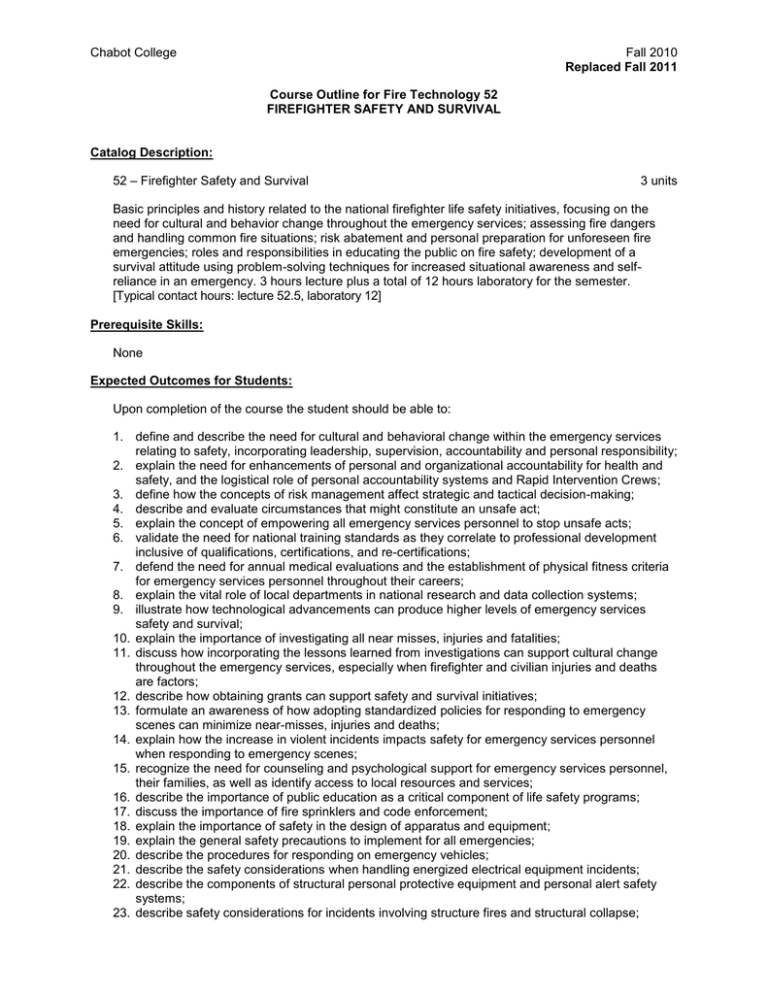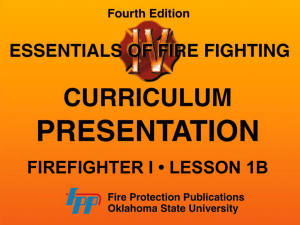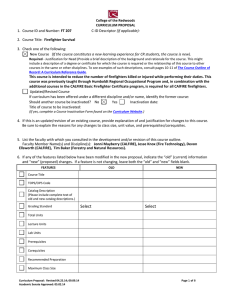Chabot College Fall 2010 Replaced Fall 2011
advertisement

Chabot College Fall 2010 Replaced Fall 2011 Course Outline for Fire Technology 52 FIREFIGHTER SAFETY AND SURVIVAL Catalog Description: 52 – Firefighter Safety and Survival 3 units Basic principles and history related to the national firefighter life safety initiatives, focusing on the need for cultural and behavior change throughout the emergency services; assessing fire dangers and handling common fire situations; risk abatement and personal preparation for unforeseen fire emergencies; roles and responsibilities in educating the public on fire safety; development of a survival attitude using problem-solving techniques for increased situational awareness and selfreliance in an emergency. 3 hours lecture plus a total of 12 hours laboratory for the semester. [Typical contact hours: lecture 52.5, laboratory 12] Prerequisite Skills: None Expected Outcomes for Students: Upon completion of the course the student should be able to: 1. define and describe the need for cultural and behavioral change within the emergency services relating to safety, incorporating leadership, supervision, accountability and personal responsibility; 2. explain the need for enhancements of personal and organizational accountability for health and safety, and the logistical role of personal accountability systems and Rapid Intervention Crews; 3. define how the concepts of risk management affect strategic and tactical decision-making; 4. describe and evaluate circumstances that might constitute an unsafe act; 5. explain the concept of empowering all emergency services personnel to stop unsafe acts; 6. validate the need for national training standards as they correlate to professional development inclusive of qualifications, certifications, and re-certifications; 7. defend the need for annual medical evaluations and the establishment of physical fitness criteria for emergency services personnel throughout their careers; 8. explain the vital role of local departments in national research and data collection systems; 9. illustrate how technological advancements can produce higher levels of emergency services safety and survival; 10. explain the importance of investigating all near misses, injuries and fatalities; 11. discuss how incorporating the lessons learned from investigations can support cultural change throughout the emergency services, especially when firefighter and civilian injuries and deaths are factors; 12. describe how obtaining grants can support safety and survival initiatives; 13. formulate an awareness of how adopting standardized policies for responding to emergency scenes can minimize near-misses, injuries and deaths; 14. explain how the increase in violent incidents impacts safety for emergency services personnel when responding to emergency scenes; 15. recognize the need for counseling and psychological support for emergency services personnel, their families, as well as identify access to local resources and services; 16. describe the importance of public education as a critical component of life safety programs; 17. discuss the importance of fire sprinklers and code enforcement; 18. explain the importance of safety in the design of apparatus and equipment; 19. explain the general safety precautions to implement for all emergencies; 20. describe the procedures for responding on emergency vehicles; 21. describe the safety considerations when handling energized electrical equipment incidents; 22. describe the components of structural personal protective equipment and personal alert safety systems; 23. describe safety considerations for incidents involving structure fires and structural collapse; Chabot College Course Outline for Fire Technology 52, Page 2 Fall 2010 24. explain safety considerations when performing fire ground operations involving ventilation, fire extinguishment, and hose line advancement; 25. explain safety considerations and procedures for vehicle fires and traffic control devices; 26. demonstrate basic firefighter survival skills when lost in a structure; 27. demonstrate methods for escaping an entrapment emergency; 28. demonstrate confidence and composure while navigating a blind course wearing respiratory protection. Course Content (Lecture): 1. Introduction a. History of fire service culture b. Organizational culture c. Individual role in culture/behavior d. History of line of duty deaths and injuries statistics e. Defining the nature of the problem 2. The national context, health and safety a. National Fire Protection Association (NFPA) b. Occupational Safety and Health Administration (OSHA) c. Medical and fitness standards d. Data collection (National Fire Incident Reporting System) e. Research/Investigation 1) National Institute of Standards and Technology (NIST) 2) National Institute of Occupational Safety and Health (NIOSH) 3. Firefighter safety training a. Certification and credentialing b. Fundamental rescue considerations 1) Recognition of personal limitations 2) Safety considerations during search and rescue 3) Basic rescue a) Emergency procedures b) Rescue techniques 4. Fire fighting apparatus and equipment a. Apparatus 1) Design standards for new apparatus 2) Licensing and certifications for vehicle operations 3) Safety considerations when operating vehicles b. Equipment 1) Fire fighting devices a) Fire extinguishers b) Hose lines c) Devices improvised in response to specific situations 2) Fire fighter personal protective equipment (PPE) a) Reasons for wearing b) Reasons for failure of clothing c) Self-contained breathing apparatus (SCBA) (1) Air consumption (2) SCBA Emergencies d) Personal alarm safety system (PASS) 5. Safe and competent response a. Role of fire department organization 1) Policies and procedures 2) Enforcement of training standards b. Responding to emergency scenes Chabot College Course Outline for Fire Technology 52, Page 3 Fall 2010 c. 6. 7. 8. 9. Handling emergency situations 1) Preplanning for emergencies 2) Fire and health danger assessment 3) Evacuating premises 4) Emergency information reporting d. Fire protection in open areas 1) Wildland 2) Transportation 3) Storage e. Safety precautions 1) Structure fires 2) Vehicle fires 3) Wildland fires 4) Violent incidents 5) All other emergency situations f. Emerging technologies Firefighter survival training a. Developing a survival attitude 1) Potential for serious injury and death 2) Situational awareness b. Mayday 1) Preventing a Mayday a) Importance of thorough scene size-up b) Preincident planning procedures 2) Situations that create or may create a Mayday 3) Mayday procedures c. SCBA emergencies 1) NFPA 1404 a) Standard for fire service respiratory protection training b) Individual air management program 2) Air consumption for survival a) Consumption rate testing b) Reducing consumption 3) Checking SCBA a) Daily check b) Emergency procedures check 4) Common SCBA emergencies 5) Alternative means of obtaining additional air Organizational health and safety profile a. Personal and organizational accountability b. Present condition/culture c. Investigations – internal d. Analyzing your profile e. Utilizing grants to meet needs Risk management a. Risk management concepts and practices b. Unsafe acts c. Empowerment definition Prevention a. Common fire and health hazards 1) Housekeeping 2) Electrical 3) Flammable gases and liquids 4) Common hazardous substances Chabot College Course Outline for Fire Technology 52, Page 4 Fall 2010 b. Fire detection devices for the home and/or workplace 1) Selection 2) Operation 3) Maintenance c. Home fire sprinklers d. Code enforcement e. Public education / fire and life safety 1) roles and responsibilities 2) principles of fire behavior 3) human behavior in fire f. Counseling and psychological support Course Content (Laboratory): 1. Personal protective equipment a. Don structure fire PPE b. Don SCBA 2. Firefighter survival skills a. Demonstrate how to read couplings using hands to follow hose toward exit b. Demonstrate how to escape entanglement using the swim or sweep method c. Demonstrate how to escape entanglement using the SCBA removal method d. Demonstrate how to call a Mayday e. Demonstrate how to perform personal procedures to assist in successful recovery f. Demonstrate how to navigate the SCBA confidence course using survival skills when needed Methods of Presentation: 1. 2. 3. 4. 5. 6. 7. 8. Lecture Group discussion Audiovisual aids Simulated problem solving Online research assignments Practical field applications Performance examinations Field trips Assignments and Methods of Evaluating Student Progress: 1. Typical Assignments a. As a member of a research group, prepare and deliver a fire service safety resource contact presentation b. Prepare a written analysis based on research of the 16 Firefighter Life Safety Initiatives c. Demonstrate methods of escaping entanglement while wearing firefighter PPE 2. Methods of Evaluating Student Progress a. Class attendance and participation b. Classroom exercises c. Homework assignments d. Weekly quizzes e. Midterm examination f. Final examination g. Manipulative performance exercises Chabot College Course Outline for Fire Technology 52, Page 5 Fall 2010 Textbook(s) (Typical): 1. 2. 3. 4. Essentials of Fire Fighting, 5th ed., IFSTA-Brady, Fire Protection Publications, 2008 Fire Service Search and Rescue, 7th ed., IFSTA, Fire Protection Publications, 2005 Fire Fighter Survival, California State Fire Training, 2010 Fire Fighter Safety and Survival Workbook, Hurtado, Chabot College, 2010 Special Student Materials: 1. Turnout coat, pants, helmet 2. Safety gloves WB: FT 52 course outline F10.doc 02/10/10


